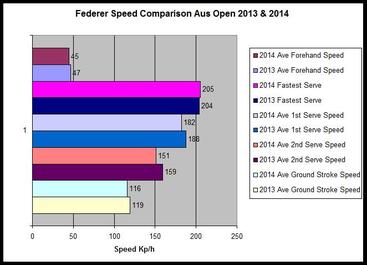 Source: IBM Tournament Stats at ausopen.com
Source: IBM Tournament Stats at ausopen.com In Formula 1 and many other sports the equipment can often be what differentiates performance between competitors. It could be said that this is also true for tennis and golf, but one could argue performance differentiation is more down to the skill of the athletes rather than the level of technology that has gone into the racquet or club. A comment by Roger Federer during January’s Australian Open got me thinking to what degree in tennis could the equipment give a competitor an advantage?
The 17 time Grand Slam winner has switched from a 90sq inch to a 98sq inch racquet head. In theory this should allow a player to increase control (due to the larger sweet spot) and importantly transfer more speed from the racquet into the ball thus giving rise to the chance of dominating from the back of the court.
When asked about the need to change Federer commented “I’m hitting the ball really well, so I’m very pleased with the racquet. It allows me to generate more speed from the base line”.
Looking at the data generally the world no. 8 is actually hitting the ball slower than he was at the Australian Open last year. Other than his marginally quicker 1st serve his main shot selections are generating a slower transfer of speed from the racquet into the tennis ball.
Although the average dip in ball speed is 3.6kp/h this isn’t enough to be a cause for concern. What is striking, however, is his perceived increase in speed. Though the frame is different the string tension is roughly the same at 21.5kg on the mains and 20kg on the cross strings which is just as it was on his previous racquet. It seems that the equipment in this case gives a psychological rather than a technical advantage. Federer won 79.9% of his first serves and 124 1stserve return points* down under which in percentage terms put him firmly back in the top 4 players in the tournament.
 RSS Feed
RSS Feed